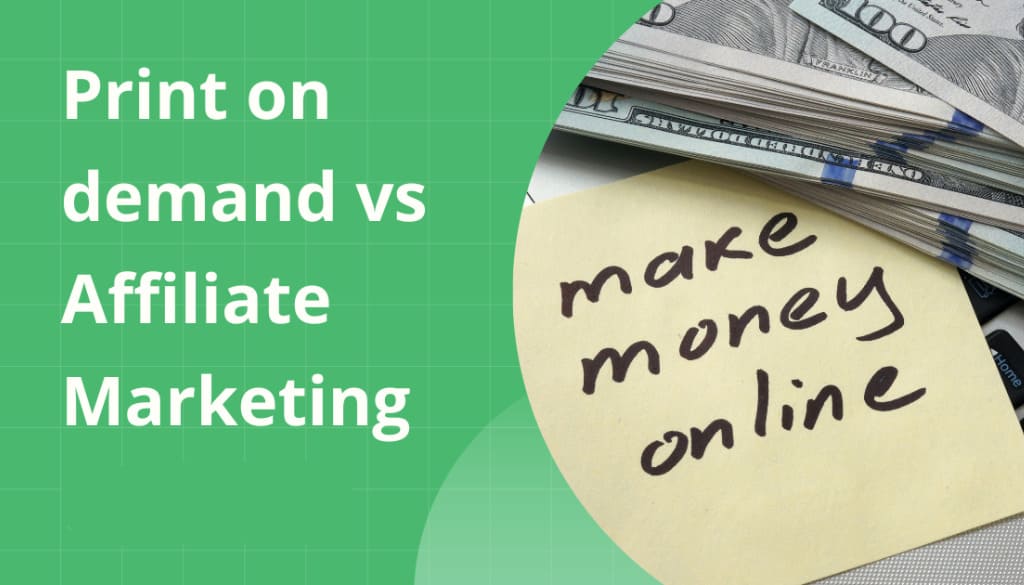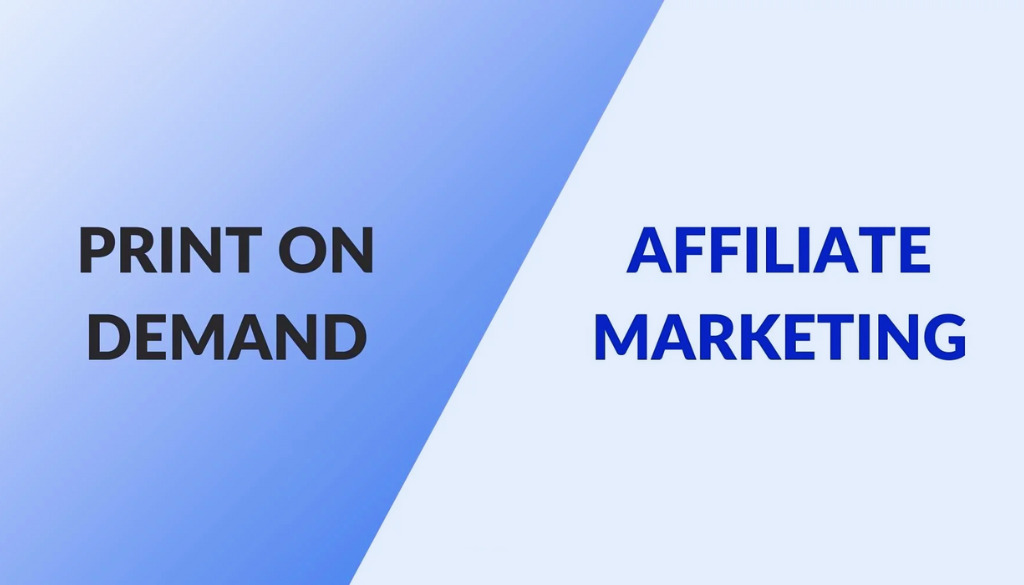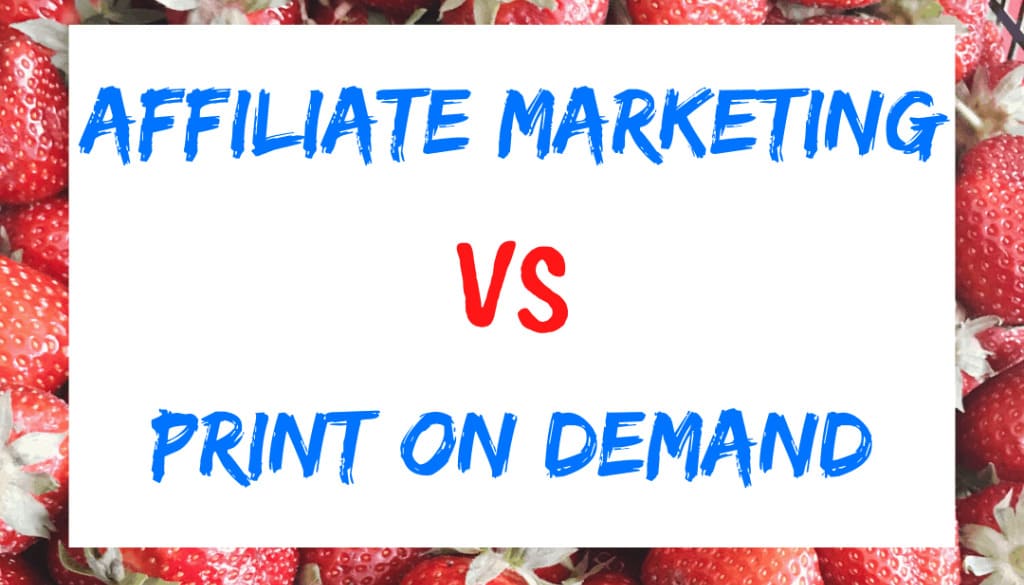In today’s booming era of e-commerce, starting an online business has become more accessible than ever. Two of the most popular models are Print-on-Demand vs Affiliate Marketing. However, many sellers, especially beginners, often wonder: “Should I choose Print on Demand or Affiliate Marketing? Which one is more suitable? Or is it possible to combine both to maximize profits?” In this article, FlashShip will provide you with a detailed analysis of these two models, comparing their strengths and weaknesses, identifying the right target audience for each, and exploring their potential combination so you can make the best decision for your business journey.
Overview of the Two Models: POD and Affiliate Marketing

Before diving into a detailed comparison, let’s first review the basic concepts to ensure we share the same frame of reference.
Print on Demand (POD)
Print on Demand is an e-commerce business model where you create and sell customized products with your own designs (such as t-shirts, mugs, phone cases, canvas prints, etc.). The unique aspect of POD is that products are only printed and manufactured after a customer places an order.
With POD, you are the one who creates the product, builds the brand, and owns the relationship with the customer.
Affiliate Marketing
Affiliate Marketing is a performance-based marketing model. In this setup, you (as a Publisher or Affiliate) promote another company’s or individual’s products or services (Advertiser/Merchant) through a unique affiliate link.
The basic process of Affiliate Marketing typically includes:
- Joining an affiliate program – You sign up for affiliate programs offered by companies (e.g., Amazon Associates) or via affiliate networks such as AccessTrade or MasOffer.
- Choosing products/services – You select products that align with your target audience or the content of your website, blog, or social media channels.
- Receiving an affiliate link – You are given a unique link containing your tracking ID.
- Promotion – You create content (reviews, videos, social media posts, email campaigns) and embed your affiliate link to promote the product.
- Customer action – When a user clicks your link and completes a specific action (most commonly making a purchase, but it could also be filling out a form or registering an account), that action is tracked.
- Earning commissions – Based on the tracked action, you receive a commission at a pre-agreed rate.
With affiliate marketing, you don’t own the product, handle order fulfillment, or manage customer service. Your main role is marketing and driving sales for someone else.
Detailed Comparison: Print-on-Demand vs Affiliate Marketing
To make things easier to visualize, let’s compare the two models based on key factors:
|
Factor |
Print on Demand (POD) |
Affiliate Marketing |
|
Initial Investment |
Low – mainly ad spend and store setup costs. |
Very low – almost zero, only requires a website/blog/social channel. |
|
Product Control |
High – you decide the design, concept, and brand. |
None – products belong to the supplier. |
|
Brand-Building Potential |
Yes – sellers can create their own POD brand. |
No – you only promote someone else’s brand. |
|
Risk |
Present: products may not sell, ad costs can be high. |
Low: no inventory risk, but dependent on affiliate policies. |
|
Profit |
Depends on product margins; can be high (30–60%). |
Usually lower commissions (5–20%). |
|
Required Skills |
Design, marketing, store management, product knowledge. |
SEO, content marketing, advertising, community building. |
|
Scalability |
Can scale into a large independent brand. |
Growth mainly comes from increasing traffic and distribution channels. |
Pros and Cons of Each Model

To make the right decision between Print on Demand and Affiliate Marketing, sellers need to clearly understand both the strengths and limitations of each model. Recognizing their pros and cons not only helps you shape an effective business strategy but also prevents unnecessary risks during execution.
Pros and cons of Print on Demand (POD)
Pros:
- Brand asset building: This is the biggest advantage. A strong brand is an invaluable asset, helping you gain loyal customers and sustainable business value.
- Full control: You decide everything—from designs, product quality (by choosing reliable suppliers like FlashShip), and pricing to marketing strategies.
- Higher profit margins: Flexible pricing allows you to achieve higher profit margins compared to earning only commissions.
- Lower risk: No inventory holding, no stock concerns, and reduced financial risks compared to traditional business models.
- Unlimited creativity: You can quickly experiment with countless ideas, designs, and niche markets.
Cons:
- More effort required: You must take on multiple roles—designer, marketer, store manager, and customer service representative.
- Dependence on fulfillment providers: Product quality, production speed, and shipping are entirely dependent on your POD partner (which is why choosing a trusted partner like FlashShip is so important).
- High competition: The POD market is becoming increasingly crowded, requiring standout designs and smart marketing strategies to stay competitive.
- Customer service responsibility: You are directly responsible for handling all customer inquiries and issues—from size consultations to resolving faulty orders.
Pros and cons Affiliate Marketing
Pros:
- Extremely low startup cost: You can begin with just a TikTok channel, a Facebook page, or a free blog.
- No worries about products or operations: Product creation, inventory management, order processing, and shipping are all handled by the supplier.
- Flexibility and freedom: You can work anytime, anywhere, and promote multiple products or companies at once.
- Easy to get started: Registering and receiving an affiliate link is usually quick and straightforward.
- Minimal financial risk: No need to invest in product sourcing or manufacturing.
Cons:
- No personal brand building: All your efforts contribute to building someone else’s brand, not your own.
- Low commissions and unstable income: As a middleman, you only earn a small share of profits. Income can fluctuate significantly and is influenced by factors beyond your control.
- Lack of product and policy control: Suppliers may change product prices, quality, commission rates, or program terms at any time.
- High traffic requirements: To generate meaningful income, you need to drive massive traffic and achieve strong conversion rates.
- Reputation risk: If you promote low-quality products, your personal credibility or your channel’s brand can be seriously damaged.
Which Model Should You Choose?

The choice between the two models largely depends on your goals, skills, resources, and personality.
Choose POD if:
- You are creative, enjoy designing, and want to build your own brand.
- You are willing to take initial risks in exchange for higher profits and long-term sustainability.
- You want full control over your products without being completely dependent on others.
Example: A seller opens an Etsy shop selling vintage-style print-on-demand t-shirts, builds a unique brand, and attracts loyal customers.
Choose Affiliate Marketing if:
- You are skilled in writing, content creation, SEO, or already have a large following on social media.
- You want to earn passive income without the hassle of managing operations.
- You prefer to avoid risks related to inventory, shipping, or returns.
Example: A tech blogger writes laptop reviews and inserts Amazon affiliate links to earn commissions from purchases.
Can You Combine Both Models?
The answer is YES and this is exactly the optimal strategy that many successful POD sellers are applying to maximize revenue and build a solid business ecosystem. Combining POD and Affiliate Marketing not only allows you to leverage the strengths of both but also helps offset their individual limitations. Here’s how you can combine them smartly:

Strategy 1: Use Affiliate Marketing to Support Your POD Store
This is the most common approach. Your POD store remains the core, but you use affiliate marketing to add value for customers and generate additional income.
- Introduce complementary products: For example, if you sell running-themed printed t-shirts, in your blogs or email marketing campaigns, alongside promoting your shirts, you could publish an article like “Top 10 Running Shoes for Beginners” and insert affiliate links to shoes sold on e-commerce platforms. Customers buying your shirts are likely to also be interested in related products.
- Create “Comparison & Review” content: You could produce content comparing your products with others in the market. For example, compare the fabric quality of your brand’s shirts with those of a major brand—while also (subtly) including affiliate links to competitor products. This provides readers with diverse options and increases the credibility of your content.
- Monetize non-converting traffic: Not every visitor to your POD store will buy. Instead of letting them leave, you can direct them to blog posts containing affiliate links on relevant topics. Even if they don’t buy your shirt, they may click an affiliate link and you still earn a commission.
Strategy 2: Use a POD Store to Build Your Affiliate Brand
If you start as an affiliate marketer and already have a community or a loyal audience, launching your own POD product line is a natural and highly effective next step.
- Create merch for your community: This is a great way to strengthen your connection with your audience while creating a lucrative revenue stream. For example, if you run a personal finance YouTube channel with signature catchphrases, print them on t-shirts or mugs and sell them to your followers. They buy not just for the product, but for the sense of support and belonging.
- Boost credibility and professionalism: Owning your own product line elevates you from simply being a “promoter” to a “branded expert.” This greatly increases your credibility in the eyes of both your audience and your partners (companies running affiliate programs).
- Leverage existing traffic: You don’t have to build a customer base from scratch. You already have a community that follows and trusts you. Introducing your own products will likely yield a much higher conversion rate.
Which Path Should You Take?
There’s no single right answer for everyone.
- If your ultimate goal is to build a lasting asset—a sustainable brand that you fully own and control then Print on Demand (POD) is the way to go. It requires more effort, but the long-term rewards are well worth it.
- If you are a content creator looking to quickly monetize your expertise without worrying about complex operations, Affiliate Marketing is an excellent starting point.
- However, the smartest and most effective path in 2025 and beyond is a harmonious combination of both. Start with the model that best fits your current strengths, but always keep a strategic vision for integrating the other model into your business ecosystem.
In this way, you’re not just creating a store that sells products you’re building a multi-channel revenue engine, where every part supports and drives the growth of the others. At FlashShip.net, we are always ready to be your trusted POD fulfillment partner, turning your creative designs into reality with top-quality printing and service, so you can confidently build your brand and conquer the market
Related Posts:

